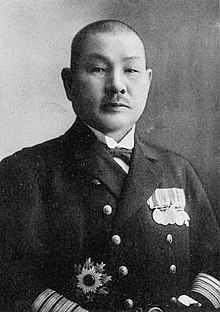Soemu Toyoda
Soemu Toyoda | |
|---|---|
| 豊田 副武 | |
 Vice Admiral Toyoda Soemu (1935-41) | |
| Chief of the Imperial Japanese Navy General Staff | |
| In office 29 May 1945 – 15 October 1945 | |
| Prime Minister | |
| Preceded by | Koshirō Oikawa |
| Succeeded by | None (office abolished) |
| Personal details | |
| Born | May 22, 1885 2nd Fleet, Naval Construction Bureau, Kure Naval District, Naval Councillor, Yokosuka Naval District, Combined Fleet, Maritime Escort Fleet, Chief of Navy General Staff[2] |
| Battles/wars | |
Soemu Toyoda (豊田 副武, Toyoda Soemu, 22 May 1885 – 22 September 1957) was an admiral in the Imperial Japanese Navy in World War II.
Biography
Early career
Toyoda was born in what is now part
Toyoda returned to school, becoming a
After his return to Japan, Toyoda was assigned as executive officer on the cruiser Kuma. He subsequently served in a number of staff positions, was promoted to captain on 1 December 1925, and received his first command: the cruiser Yura in 1926. In December 1930, he became captain of the battleship Hyūga. During the London Naval Conference, he accompanied Admiral Isoroku Yamamoto to London in 1931. On 1 December 1931, Toyoda was promoted to rear admiral.
From December 1931 to February 1933, Toyoda was chief of the Second Section of the
From 1935 to 1937, Toyoda was Director of the Bureau of Naval Affairs, and on 20 October 1937, became
World War II
Promoted to full admiral on 18 September 1941, at the time of the attack on Pearl Harbor, Toyoda was Commander-in-Chief of the Kure Naval District. Toyoda was strongly opposed to the war with the United States, which he viewed from the start as "unwinnable".[3]
On 10 November 1942, Toyoda became a member of the Supreme War Council, where he made a strong (but mostly unsuccessful) effort to increase funding and the capacity of Japan's industry toward naval aviation, over the opposition to the Army-dominated Imperial General Headquarters. On 21 April 1943, Toyoda was reassigned (i.e. demoted) from the Supreme War Council to command of Yokosuka Naval District.
After the death of Admiral
Toyoda replaced Koshirō Oikawa as Chief of the Navy General Staff, after the latter resigned, and was the final supreme commander of the Imperial Japanese Navy from 29 May 1945 onward.
Toyoda participated in numerous
Post-war
After the war, Toyoda was interrogated by Rear Admiral Ralph A. Ofstie in Tokyo on 14 November 1945. He was viewed as "highly intelligent and widely informed", and was observed to be a strong critic of the amount of political power the Army held in the Japanese government. He also expressed his opinion that the war with China should have been ended "even at some sacrifice" so that the men and resources could be redeployed to the Pacific theater.[4]
Toyoda was subsequently arrested by
Toyoda published his memoirs in 1950, and died in 1957 of a
References
Notes
- ^ Nishida, Imperial Japanese Navy.
- ^ "Naval History of WW2".
- ^ Utah State Library, Toyoda Trial Transcripts
- ^ Utah State Library, Toyoda Trial Transcripts
Books
- Butow, Robert J. C. (1954). Japan's Decision to Surrender. Stanford University Press. ASIN: B000VFCC14.
- Dull, Paul S. (1978). A Battle History of the Imperial Japanese Navy, 1941–1945. Naval Institute Press. ISBN 0-87021-097-1.
- Frank, Richard B. (1999). Downfall: the End of the Imperial Japanese Empire. Penguin, non-classics. ISBN 0-14-100146-1.
- Sheftall, M. G. (2005). Blossoms in the Wind: Human Legacies of the Kamikaze. NAL Caliber. ISBN 0-451-21487-0.
- Y'Blood, William T. (2003). Red Sun Setting: The Battle of the Philippine Sea. Naval Institute Press. ISBN 1-59114-994-0.
External links
- Nishida, Hiroshi. "Imperial Japanese Navy". Archived from the original on 2014-03-14. Retrieved 2007-08-25.
- Utah State Library Toyoda Soemu Trial Transcripts
